

Beans are a favorite in the veggie patch, and not only for us! Many types of bean blight exist, caused by fungus, viruses, mites and bacteria. They infect bean plants and trigger brown or yellow spots,wilt, and other issues on bean leaves, bean pods and vines.
Here are the main culprits responsible for bean blight.
Fungus, virus, bacteria and mites trigger the following seven of the many diseases bean plants can catch.
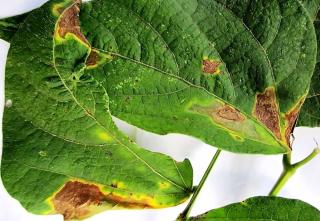 Common bean blight, or common bacterial blight, is the result of infection by either of two related bacteria. One of these also infects citrus plants, so it’s more likely to appear if you’ve also got a citrus orchard nearby.
Common bean blight, or common bacterial blight, is the result of infection by either of two related bacteria. One of these also infects citrus plants, so it’s more likely to appear if you’ve also got a citrus orchard nearby.
Phytophthora blight is a plant disease where bean pods turn mushy and mold away. Usually this happens when the pods form near the soil. Varieties with very long pods like string beans are more vulnerable since they occasionally reach down to the ground.
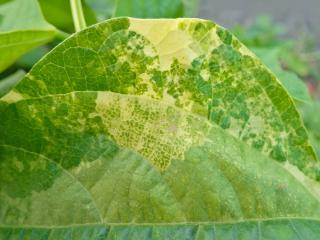 Red spider is a type of mite that feeds on sap. It drains leaf cells of their chlorophyll, turning them pale yellow. Webs appear.
Red spider is a type of mite that feeds on sap. It drains leaf cells of their chlorophyll, turning them pale yellow. Webs appear.
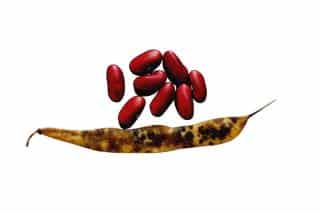 Halo blight results in round spots forming on bean leaves and pods. In extreme cases, vines dry out.
Halo blight results in round spots forming on bean leaves and pods. In extreme cases, vines dry out.
Note the last word in the name to distinguish it from halo blight above: the “pathovar” descriptive is different. This is the same species of bacteria as above, but it’s a different group within the species. Interestingly, symptoms are different because the spots on the leaves don’t look the same. For instance, the color of this infection is a deep brown, hence its other common name: chocolate spot of bean.
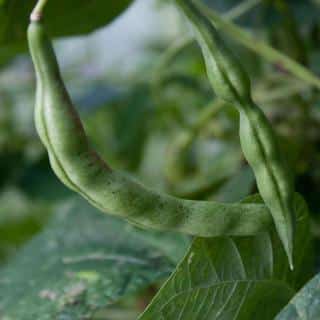 The bacteria causing this disease also infects other host plants. Initially, brown spots form that seem swollen with water. As it spreads in the plant, it eventually reaches the root system. It causes the roots to rot, to the point they can’t channel water to the vine and stem anymore. In a few days, leaves show signs of chlorosis, the plant wilts, dries up and dies from tip to root.
The bacteria causing this disease also infects other host plants. Initially, brown spots form that seem swollen with water. As it spreads in the plant, it eventually reaches the root system. It causes the roots to rot, to the point they can’t channel water to the vine and stem anymore. In a few days, leaves show signs of chlorosis, the plant wilts, dries up and dies from tip to root.
Another group from this same species, Curtobacterium flaccumfaciens pv. oortii, infects tulip bulbs. It causes bacterial canker in tulip (yellow pustule).
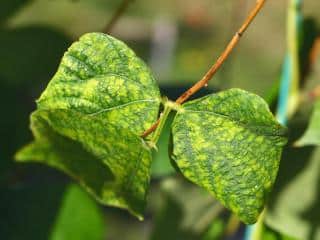 Viruses are the cause of dreaded mosaic bean blight. Leaves take on a patchy appearance, portions turning yellow while the rest remains unscathed. These viruses don’t get there on their own: host pests inject them into the plant.
Viruses are the cause of dreaded mosaic bean blight. Leaves take on a patchy appearance, portions turning yellow while the rest remains unscathed. These viruses don’t get there on their own: host pests inject them into the plant.
The first and most effective manner to avoid having to deal with these diseases every year is crop rotation. Most of these pathogens only stay for 2 or 3 years in high amounts in the soil. This means that you should practice a 4-year crop rotation plan. By the time beans grow on the same plot of soil again, levels of bacteria will have dropped to very low levels. They won’t be able to devastate your crops entirely.
However, it’s nearly impossible to eradicate them completely just by rotating the plants over 4 years. There will always be a few bacteria that will reappear. Nonetheless, they won’t be numerous enough to cause any real damage.
Crop rotation is, by far, the most natural solution to prevent bean leaf blight: no additives and no extra work! All you have to do is avoid planting beans in the same spot, and infection drops to acceptable levels.
These bacteria and oomycete spread thanks to water. Keeping leaves dry is an excellent way to help protect the plants.
Your comment is awaiting moderation.
Thank you- Great information- Address treatment for diseases